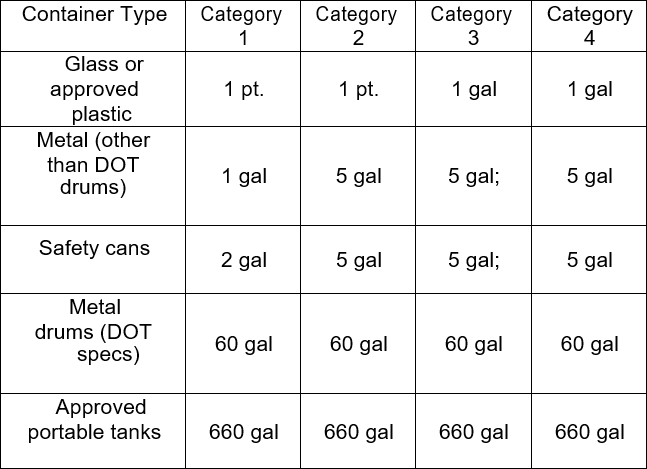601 - Flammable Liquids and Aerosols
Definitions
A. Aerosol – a material dispensed from its container as a mist, spray, or foam by a propellant under pressure.B. Flammable Liquid – any liquid having a flashpoint at or below 199.4 °F (93 °C).
B. Flammable liquids are divided into four categories as follows:
a. Category 1 shall include liquids having flashpoints below 73.4 °F (23 °C) and having a boiling point at or below 95 °F (35 °C).
b. Category 2 shall include liquids having flashpoints below 73.4 °F (23 °C) and having a boiling point above 95 °F (35 °C).
c. Category 3 shall include liquids having flashpoints at or 73.4 °F (23 °C) and at or below 140 °F (60 °C). When a Category 3 liquid with a flashpoint at or above 100 °F (37.8 °C) is heated for use to within 30 °F (16.7 °C) of its flashpoint, it shall be handled in accordance with the requirements for a Category 3 liquid with a flashpoint below 100 °F (37.8 °C).
d. Category 4 shall include liquids having flashpoints above 140 °F (60 °C) and at or below 199.4 °F (93 °C). When a Category 4 flammable liquid is heated for use to within 30 °F (16.7 °C) of its flashpoint, it shall be handled in accordance with the requirements for a Category 3 liquid with a flashpoint at or above 100 °F (37.8 °C).
C. Maximum Capacity. No more than 60 gallons of Category 1, 2, or 3 flammable liquids, nor more than 120 gallons of Category 4 liquids may be stored in a storage cabinet.
D. Safety Can – an approved container with no more than five gallons capacity, having a spring-closing lid and spout cover and so designed that it will safely relieve internal pressure when subjected to fire exposure.
E. Sources of Ignition – in locations where flammable vapors may be present, precautions shall be taken to prevent ignition by eliminating or controlling sources of ignition. Sources of ignition may include open flames, lightning, smoking, cutting, and welding, hot surfaces, frictional heat, sparks (static, electrical, and mechanical), spontaneous ignition, chemical and physical-chemical reactions, and radiant heat.
- Each employee shall know the hazards of the flammable liquids used in his/her job.
- Store flammable liquids in approved storage cabinets or rooms. No smoking or open flames shall be permitted in areas where flammable liquids are stored or dispensed.
- Do not store materials other than flammable liquids in flammable liquid storage cabinets.
- Aerosol cans that contain flammable liquids, including aerosols containing a flammable propellant, shall be stored in flammable storage cabinets. Aerosols and flammable liquids may be stored together.
- Never use gasoline to start fires or for cleaning purposes. Do not dispense gasoline unless a safety can or tank designed for gasoline dispensing is used.
- Drums containing flammable liquids shall not be pressurized to transfer the contents.
- Do not place flammables liquids near open flames, welding operations, or other sources of ignition.
- Ensure all equipment, such as tank trucks or portable containers, used for handling or storage of flammable liquids is bonded and grounded during transfer of the flammable liquid. Also, a metal-to-metal bond shall be made between the dispensing and receiving containers. Dispensing from portable tanks or drums shall be through the top using an approved pump or by gravity through a self-closing valve.
- The quantity of flammable liquid that may
be located outside of an inside storage room or storage cabinet in a building
or in any one fire area of a building shall not exceed:
- 25 gallons of Category 1 flammable liquids in containers
- 120 gallons of Category 2, 3, or 4 flammable liquids in containers
- 660 gallons of Category 2, 3, or 4 flammable liquids in a single portable tank.
- Cabinets shall be labeled with conspicuous lettering, FLAMMABLE – KEEP FIRE AWAY.
- All portable storage tanks and storage areas for flammable liquids shall be vented.
- Maximum allowable size of containers and portable tanks for flammable liquids:

NOTE: Container exemptions: 9a) medicines, beverages, foodstuffs, cosmetics, and other common consumer item, when packaged according to commonly accepted practices, shall be exempt from the requirements of 1910.106(d)(2)(i) and (ii).
13. Flammable liquids or other materials shall not be stored in areas that limit or prohibit the use of exits, stairways, or other areas normally used for the safe access/egress of people.
14. An approved safety can used for fuel is defined as an Underwriters Laboratory (UL) approved container.
Note: For a complete list of requirements please refer to 29 CFR 1910.106 Flammable Liquids.
